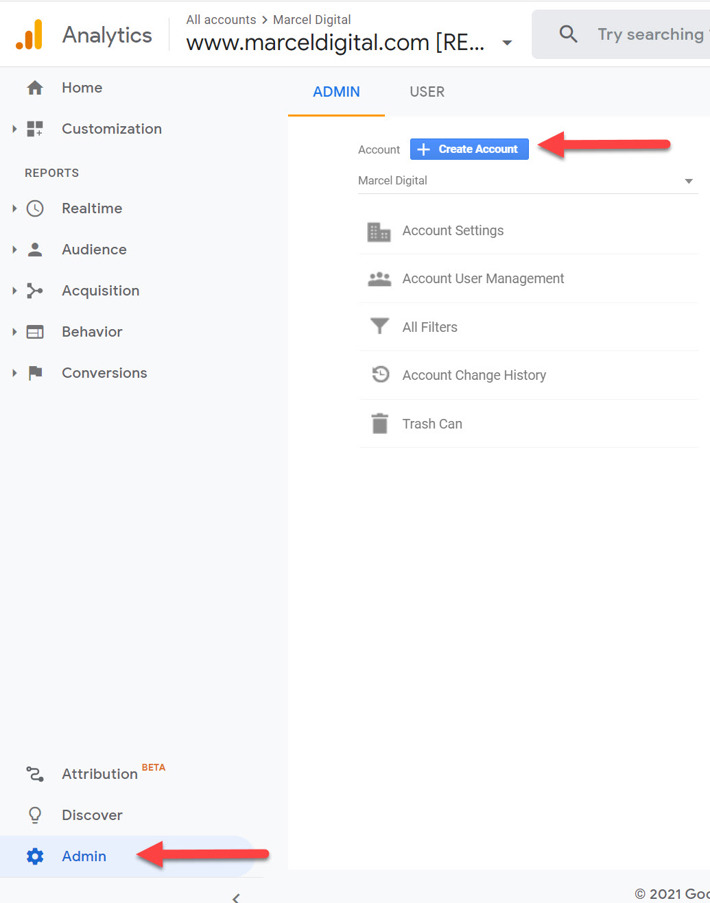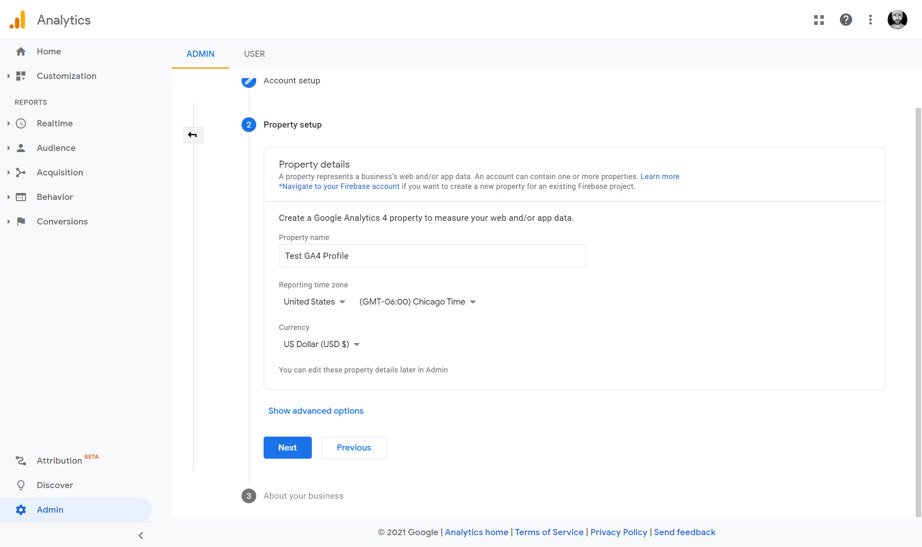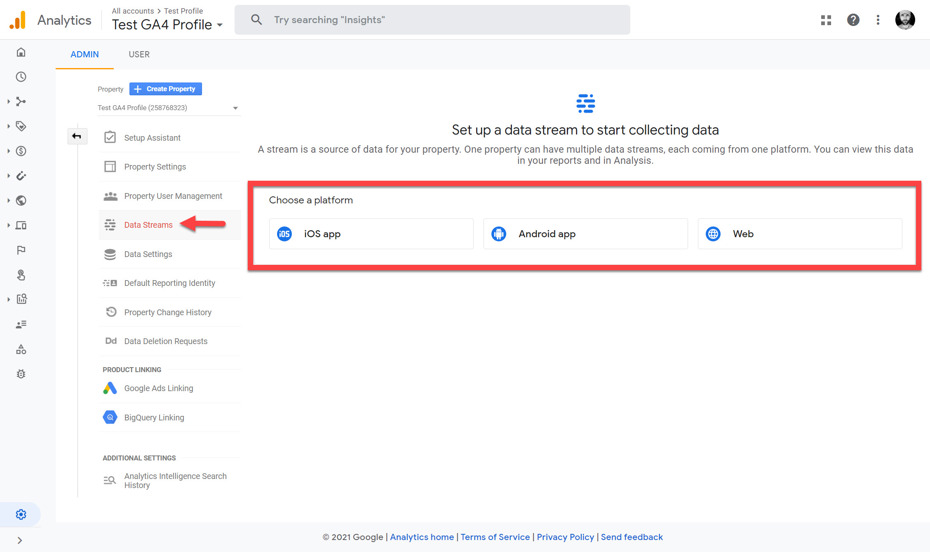
Google released a new version of its web analytics service in October 2020, which collects data and analyzes web traffic. This version is known as Google Analytics 4 (GA4) and is the new default for Google Analytics (GA).
Millions of businesses use GA to monitor their marketing channels and measure their Key Performance Indicators (KPIs).
GA4 has many features that differentiate it from its Universal Analytics (UA) processor. The new data modeling capability is one of the biggest of these, as it uses behavior modeling to fill in gaps left by UA. The new Google Analytics user interface (UI) is also different from UA.
What Is GA4?
GA4 is also based on the same platform as the "App + Web" system that Google released in 2019, which allowed marketers to track users across applications, software, and websites.
The main goal of all these capabilities is to analyze the behavior of users, especially their journey toward becoming customers. Events are also a major part of GA4 since they describe the presentation of data.
According to Google, the primary purpose of GA4 is to provide a next-generation approach to AI-based predictive data, privacy-first tracking, and cross-platform measurement. GA4’s advanced machine learning (ML) models also allow it to provide data for user behavior and website traffic without relying on the hits for each page.
GA4 is particularly useful because website visitors are increasingly likely to opt out of cookie usage and other means of data collection. New privacy protection laws like the California Consumer Privacy Act (CCPA) and the General Data Protection Regulation (GDPR) reduce the usefulness of traditional analytics like UA.
Businesses that rely on these services often need help with missing or inaccurate data due to the cookie consent options that these laws require. GA4 is built to adapt to a future with or without cookies.
Highlights of GA4
The major highlights of GA4 include its seamless integration with Google tools, ML capability, and scalable cross-platform analytics.
Integration with Google Tools
GA4 is closely integrated with YouTube, and Google is working to improve its evaluations for YouTube advertising campaigns.
These changes allow users to track view-through conversions, which measures a campaign's effect on the involvement of specific audiences, bounce rates, and website events.
The deeper integration of GA4 with Google Ads allows users to run campaigns that provide relevant and useful offers to specific audiences, regardless of the device they’re using to surf the web.
In addition, the BigQuery Export feature is free for all GA4 users, whereas this feature is only available to users of the paid version of UA. GA4 also has resource settings that allow users to activate data collection in BigQuery cloud storage.
Machine Learning
GA4’s machine learning (ML) capability and natural language processing (NLP) functions are one of the main benefits of Google Analytics 4. They allow users to estimate the probability of converting visitors into customers.
Users can also develop audiences for Google Ads based on that probability and receive notifications on conversion trends, such as how product demand changes user requirements.
GA4 can also predict customer behavior so users can make the investments needed to retain them. Google will continue developing GA4 to add additional forecasts like average revenue per user (ARPU), allowing users to adjust their marketing strategies further and increase their return on investment (ROI).
Cross-platform Analytics
It has been historically difficult to analyze a visitor's transition between platforms, such as a website to an app because there has yet to be a universal standard of visitor behavior. For example, UA builds its information around visitor sessions, while Firebase, Google's platform for developing mobile and web applications, uses events.
GA4 addresses this limitation by using an event-based approach to analytics that collects standardized data across multiple platforms.
This approach improves the data quality and provides users with a single report across visitor paths.
Quota Limits
Google sets quotas limits to prevent users from overloading the API with too many requests simultaneously.
These quota limits act as a guardrail to ensure the system does not receive more data than it can handle. According to Google's Developer Quota Resource, these can vary and are subject to change.
Google Analytics 4 vs Universal Analytics
Application and website owners migrating from UA to GA4 must understand the differences between the two analytics services. These include events, sessions, and hit types.
Events
Event handling is fundamentally different between UA and GA4. UA events have a category, action, and label, while GA4 doesn’t recognize these concepts as they exist in UA.
Unlike UA, each hit is an event in GA4, so GA4 doesn’t distinguish between hit types. Migrating to GA4 requires a new event structure for collecting data in most cases rather than simply porting the existing structure over to GA4.
However, automatically collected and enhanced measurement events don't require users to add code to an application or web page.
Sessions
A session is a set of interactions between visitors and websites within a given timeframe. They usually end after 30 minutes of inactivity or until a qualifying event resets the session. UA sessions comprise multiple pageviews, events, interactions, and transactions.
However, a GA4 session is explicitly defined by the session_start event, which is an automatically collected event. The period between events determines the end of a session in GA4.
Determining active users is another difference in session definition between the two analytics tools. UA relies on manual instrumentation, like an interactive event, to establish when a user is active, whereas GA4 detects user activity automatically.
This difference means a user who launches an application is active under GA4 but not UA. These differences can result in discrepancies in sessions between UA and GA4. For example, GA4 generally has a higher active user count than UA.
Hit Types
UA hit types include event, eCommerce, page, and social interaction hits. However, GA4's property measurements are event-based, meaning it can capture any interaction as an event. As a result, GA4 translates UA hit types into events within a GA4 property.
Should You Switch to Google Analytics 4?
Yes, it would help if you transitioned to GA4. Why? Because on July 1, 2023, Universal Analytics is going away (July 1, 2024, for Analytics 360) and will be replaced by Google Analytics 4. Users should understand the pros and cons when migrating from UA to GA4.
Pros
GA4's AI and ML capabilities are among its biggest advantages over UA. These capabilities make GA4 a better analytical tool, allowing it to predict the future.
It could be better, but GA4 can notify users of developing trends. ML lets users make better sense of the data they collect, allowing them to predict visitor behavior more accurately.
Codeless tracking of events is another great feature of GA4. Users can now track events in real-time without any coding knowledge, providing more information on how visitors interact with a website.
GA4 adds video to UA's existing tracking events, including page scrolls and clicks. This addition means that users can count the number of visitors watching a video in real time.
Cons
Users with a lot of experience in UA may hesitate to migrate to GA4 due to the many changes that GA4 introduces. These changes greatly affect the data users receive and how they view it.
For example, the tools for collecting, analyzing, and reporting data are now separate, so GA4 users have more options. The data organization is also different since UA has the tiers of Account, Property, and View, whereas GA4 only has Accounts and Property. Furthermore, some of the UA reports need to be included in GA4.
How to Set Up GA4
Check out this Google Support article for an in-depth overview of the steps needed to set up Analytics for a website and app. Setting up GA4 on a new application or website requires the following steps:
- Create an Analytics account
- Create a GA4 property
- Add a data stream
- Setup data collection
Create an Analytics Account
You only need to create an Analytics account if this is the first time you've used any version of Analytics.
Click Create Account in the Admin section of the Account column.

Enter your account name and configure the data-sharing settings to specify the data you want to share with Google.
Add properties to the Account by clicking Next.
Create a Google Analytics 4 Property
Enter the property’s name, reporting time zone, and currency.
The time zone is the day boundary for reports, regardless of their data’s origin. Changing the time zone later only affects future data.
Click Next to select the industry category and business size.
Click Next and select how you intend to use Google Analytics. This will tailor the set of default reports that are created.
Click Create and accept the terms of service and data processing amendment.

Enter your account name and configure the data-sharing settings to specify the data you want to share with Google.
Add properties to the Account by clicking Next.
Create a Google Analytics 4 Property
Enter the property’s name, reporting time zone, and currency.
The time zone is the day boundary for reports, regardless of their data’s origin. Changing the time zone later only affects future data.
Click Next to select the industry category and business size.
Click Next and select how you intend to use Google Analytics. This will tailor the set of default reports that are created.
Click Create and accept the terms of service and data processing amendment.

Set Up Data Collection
Add the Analytic tag to each web page where you want to collect data in your GA4 property.
Add the global site tag to a website builder or Content Management System (CMS)-hosted websites like Shopify or WordPress.
You must also add the global site tag directly to your web pages using Google Tag Manager.
What's Changed with GA4?
In retrospect, a lot changed from Universal Analytics to Google Analytics 4 because GA4 uses a drastically different data structure and collection logic than UA.
Everything is built around users and events rather than sessions. With an event-based approach, every user interaction is a self-contained event.
This differs from a session-based model, where user interactions are grouped based on what happens in a given timeframe.
This gives marketers a major advantage as they look to cross-platform analytics, and it makes GA4 flexible and improves user behavior prediction.
How Does GA4 Help with Reporting Data?
Because of the explosion of data privacy concerns, tracking users as they switch between platforms and devices is increasingly difficult.
GA4 provides a future-proof solution using machine learning techniques to fill in the holes in data. This creates a unified user path for all the data associated with a single user.
GA4 simplifies the reporting interface to make key trends and irregularities stand out quickly.
GA4 uses overview reports with summary cards, allowing you to dig deeper with a simple click on the scorecard.
Best Features of GA4
The home page provides a high-level summary of a property's overall traffic, conversion, and revenue. This will allow you to see where new users are coming from instantly, top-performing campaigns, and which pages and screens get the most views.
Real-time reports show events that happened within the last half hour. This helps you confirm tracking code is working and lets you view effects from a YouTube video or a new product drop as it happens.
Another powerful feature of GA4 is the new Analysis Hub that gives you access to advanced data display methods. This can help you make sense of your data or explain it to your team or clients.
An analysis hub can be displayed using the following:
- Funnel analysis – Visualize the steps shoppers take to complete an event and see how they manage at each step of the process.
- Path analysis – This displays the event stream as a tree graph to show the series of events users triggered. This may reveal a loop where users appear to be getting stuck.
- Segment overlap – Segments, or cross-sections of users, can be created based on multiple conditions. For example, you may wish to view data based on users from a particular locale, those that visited a specific page, or those who purchased a product.
- Cohort analysis – A cohort group is a group of users with a common characteristic like the same acquisition date, an event, or conversion. For example, this could show how long it takes to convert when using a specific marketing strategy.
Need Help Migrating to GA4?
Our team of experts is here to help. We've already successfully migrated organizations just like yours to GA4. Don't wait until it's too late.

Analytics
About the author
Dan Kipp
Dan Kipp is the Google Analytics and Google Tag Manager guru at Marcel Digital. He loves traveling, cooking, sports, and spending spare time with friends and family.